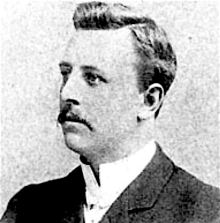
Henry Thomas Hare [also known as Henry Hare and as Henry T. Hare] was born in Scarborough, Yorkshire, England on 7 September 1860 and was articled to Charles Augustus Bury (1845-1916) in Scarborough from 1876 to 1880. He then moved to Paris where he attended the Atelier Ginain and the École des Beaux-Arts in 1881. Following his return to England he worked in the office of Zephaniah King (1834?-1906) and Richard Hill Harris (c.1853-1909) of King & Hill in London from 1882 to 1890. He qualified as an architect in 1886 and commenced independent practice at 5 Oval Road, Regent's Park, London in 1891. He was for a period associated with Thomas Davison and was in partnership with Bertram Edwin Lisle (1886-1962) until 1921.
Hare was elected an Associate of the Royal Institute of British Architects (ARIBA) in 1887 and a Fellow of the Royal Institute of British Architects (FRIBA) in 1898. From 1917 to 1919 he served as President of the Royal Institute of British Architects (PRIBA). He was also President of the Architectural Association in 1902-03. He was awarded the Ashpitel Prize in 1886.
Hare's address was given as 3 Regent's Park Villas, Gloucester Gate, London in 1886; 5 Oval Road, Regent's Park, London in 1891; 13 Hart Street, Bloomsbury Square, London in 1898 and 1910; 7 Gray's Inn Square, London in 1914; and 2 Gray's Inn Square, London in 1920. He died in Farnham Common, Buckinghamshire on 10 January 1921.
A biographical file on Henry Thomas Hare is available on request at the Enquiry Desk, Royal Institute of British Architects Library, London
County Buildings in Stafford, Staffordshire (1893–95); Oxford Town Hall in Oxford, Oxfordshire (1893–97); the Passmore Edwards Free Library in Hackney, London (1897–99); Westminster (Presbyterian) College in Cambridge (1897-99); Hoxton Public Library in Hoxton, London (1898); Henley Town Hall in Henley-on-Thames, Oxfordshire (1899–1900); the Technical College in Southend-on-Sea, Essex (1900); Bailey Hill Water Tower in Luton, Bedfordshire (1901); Tunbridge Wells Adult Education Centre in Tunbridge Road, Kent (1902); Wolverhampton Public Library (1902); Southend-on-Sea Public Library (1903); Municipal Buildings in Crewe, Cheshire (1902–05); Municipal Buildings in Pontypridd, Wales (1903); Public Library in Shoreditch, London (1904); Art Gallery in Harrogate, Yorkshire (1904); Ramsgate Library in Ramsgate, Kent (1904); Carnegie Central Library in Shepherd's Bush, London (1905); Central Library in Islington, London (1905); Malvern Library in Malvern, Worcestershire (1905-06); Ingram House for the Provident Institution in London (1906); Westfield House [later the Central Library] in Fulham, London (1908); Public Library in Blackheath, London (1909); The Stray, Egypt Lane, Farnham Royal, Buckinghamshire (c.1910); University College of North Wales in Bangor (1911); buildings for Queen's College, Cambridge (1912); and Francis Holland School in London (1912).
Armstrong, Barrie and Armstrong, Wendy. The Arts and Crafts movement in the North West of England: a handbook. Wetherby, England: Oblong Creative Ltd., 2006
Dewe, Michael. Henry Thomas Hare, 1860-1921: an Edwardian public library architect and his work, M.A. thesis, University of Strathclyde, 1981
Directory of British Architects 1834-1914. Compiled by Antonia Brodie, et al. Volume 1: A-K. London; New York: British Architectural Library, Royal Institute of British Architects/Continuum, 2001
Gray, A. Stuart. Edwardian architecture: a biographical dictionary. London: Gerald Duckworth & Co., Ltd., 1985
‘Obituary’. American Institute of Architects Journal vol. 9, 1921 p. 100
‘Obituary’. Architectural Review vol. 49, February 1921 p. 54
‘Obituary’. The Builder vol. 120, 14 January 1921 pp. 59, 67
‘Obituary’. The Builder vol. 120, 21 January 1921 pp. 90, 93-94
‘Obituary’. Royal Institute of British architects Journal vol. 28, 1921 pp. 173, 180, 121